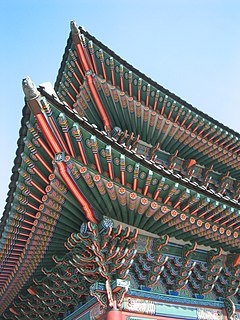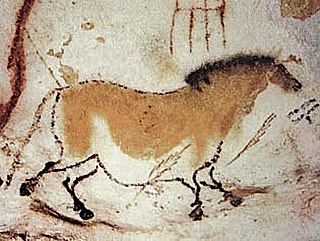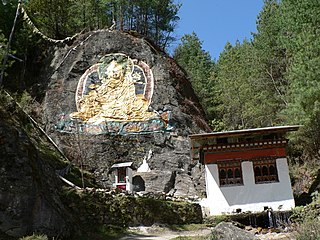Related Research Articles

Sculpture is the branch of the visual arts that operates in three dimensions. It is one of the plastic arts. Durable sculptural processes originally used carving and modelling, in stone, metal, ceramics, wood and other materials but, since Modernism, there has been an almost complete freedom of materials and process. A wide variety of materials may be worked by removal such as carving, assembled by welding or modelling, or moulded or cast.

The culture of Korea is the shared cultural and historical heritage of Korea and southern Manchuria. As one of the oldest continuous cultures in the world, Koreans have passed down their traditional narratives in a variety of ways. Since the mid-20th century, Korea has been split between the North and South Korean states, resulting today in a number of cultural differences. Before the Joseon Dynasty, the practice of Korean shamanism was deeply rooted in Korean culture.

The Jade Buddha Temple is a Buddhist temple in Shanghai. As with many modern Chinese Buddhist temples, the current temple draws from both the Pure Land and Chan traditions of Mahayana Buddhism. It was founded in 1882 with two jade Buddha statues imported to Shanghai from Myanmar by sea. These were a sitting Buddha, and a smaller reclining Buddha representing the Buddha's death. The temple now also contains a much larger reclining Buddha made of marble, donated from Singapore, and visitors may mistake this larger sculpture for the original, smaller piece.

The Seokguram Grotto is a hermitage and part of the Bulguksa temple complex. It lies four kilometers east of the temple on Mt. Tohamsan, in Gyeongju, South Korea. It is classified as National Treasure No. 24 by the South Korean government and is located at 994, Jinhyeon-dong, Gyeongju-si, Gyeongsanbuk-do. The grotto overlooks the Sea of Japan and rests 750 meters above sea level. In 1962, it was designated the 24th national treasure of Korea. In 1995, Seokguram was added to the UNESCO World Heritage List together with the Bulguksa Temple. It exemplifies some of the best Buddhist sculptures in the world.

Greco-Buddhist art is the artistic manifestation of Greco-Buddhism, a cultural syncretism between the Classical Greek architecture and Buddhism. Greco-Buddhist art is characterized by the strong idealistic realism and sensuous description of Hellenistic art and it is believed to be the first representations of the Buddha in human form.

The culture of Indonesia has been shaped by long interaction between original indigenous customs and multiple foreign influences. Indonesia is centrally-located along ancient trading routes between the Far East, South Asia and the Middle East, resulting in many cultural practices being strongly influenced by a multitude of religions, including Buddhism, Christianity, Confucianism, Hinduism, and Islam, all strong in the major trading cities. The result is a complex cultural mixture very different from the original indigenous cultures.

The Dazu Rock Carvings are a series of Chinese religious sculptures and carvings located in Dazu District, Chongqing, China. The carvings date back as far as the 7th century AD, depicting and influenced by Buddhist, Confucian and Taoist beliefs. Some are in rock-cut cave shrines, in the usual Chinese Buddhist style, but many others are rock reliefs carved into the open rock faces.

The history of Asian art includes a vast range of arts from various cultures, regions and religions across the continent of Asia. The major regions of Asia include Central, East, South, Southeast, and West Asia.

Korean arts include traditions in calligraphy, music, painting and pottery, often marked by the use of natural forms, surface decoration and bold colors or sounds.

The sculpture of Japan started from the clay figure. Japanese sculpture received the influence of the Silk Road culture in the 5th century, and received a strong influence from Chinese sculpture afterwards. The influence of the Western world was received since the Meiji era. The sculptures were made at local shops, used for sculpting and painting. Most sculptures were found at areas in front of houses and along walls of important buildings.

Buddhist art is the artistic practices that are influenced by Buddhism. It includes art media which depict Buddhas, bodhisattvas, and other entities; notable Buddhist figures, both historical and mythical; narrative scenes from the lives of all of these; mandalas and other graphic aids to practice; as well as physical objects associated with Buddhist practice, such as vajras, bells, stupas and Buddhist temple architecture. Buddhist art originated on the Indian subcontinent following the historical life of Siddhartha Gautama, 6th to 5th century BCE, and thereafter evolved by contact with other cultures as it spread throughout Asia and the world.

The National Museum of Nepal is a popular attraction of the capital city of Kathmandu. About a century old, the museum stands as a tourist destination and historical symbol for Nepal. Being the largest museum of the country of Nepal, it plays an important role in nationwide archaeological works and development of museums. For the residents of Kathmandu, the monument serves to relive the battles fought on the grounds of Nepal. The main attractions are collection of historical artworks and a historical display of weapons used in the wars in the 18-19th century. The museum has separate galleries dedicated to statues, paintings, murals, coins and weapons. It has three buildings — Juddha Jayatia Khate Sala, Buddha Art Gallery and the main building which consists of natural historical section, cultural section and philatelic section.
Korean Buddhist sculpture is one of the major areas of Korean art. Some of the finest and most technically accomplished Buddhist sculpture in East Asia and World were produced in Korea.

Bhutanese art is similar to Tibetan art. Both are based upon Vajrayana Buddhism and its pantheon of teachers and divine beings.

The Rock-carved triad buddha in Seosan is located at Gayasan, Unsan-myeon, Seosan, Chungcheongnam-do. The Standing Buddha Reborn was sculptured in the center which is 208 centimeter high, with a standing image of a bodhisattva on his right side and an image of the Bangasayusang on his left side. It is also known as "the smile of the Baekje", and it is considered to be a notable example of Buddhist images carved on rock cliffs and which were made by digging into the natural rocks and sculpting the statue.
Kim Bak-young was a Living National Treasure as a maker of Korean bows. He used wooyoun as a pseudonym.
Soban are small tray-like tables, usually wooden, used in Korea for carrying food and as individual dining tables. They are generally made of walnut, pine or ginko wood, often sourced from the carpenter's local area. Carvings and murals showing images of soban have been found in tombs dating back to the time of the Goguryeo kingdom. As well as being used for dining, soban were also used for general carrying tasks, as writing desks and as small altars for prayers or for burning incense.

Busan Museum is a museum located in Busan, South Korea, open since 1978.

It is quite difficult to define Indonesian art, since the country is immensely diverse. The sprawling archipelago nation consists of 17.000 islands. Around 922 of those permanently inhabited, by over 600 ethnic groups, which speak more than 700 living languages.

Hirakushi Denchū or Hiragushi Denchū was a Japanese sculptor. He was noted for his traditional Japanese wood sculptures, especially realistically rendered painted wooden portrait sculptures, often incorporating Buddhist themes. He was appointed to the Imperial Art Academy in 1937 and in 1944 was appointed an Imperial Household Artist. He was named a Person of Cultural Merit in 1954 and in 1962 was awarded the Order of Cultural Merit.
References
- 1 2 3 4 5 "Engraving the Korean Spirit into Wood". Arirang News. Retrieved 10 April 2013.
- 1 2 "Take a spring time stroll in one of the cherished gardens of Buddha". Welcome To Korea. Radio Korea International/KBS. Retrieved 10 April 2013.
- ↑ Korea Newsreview. Korea Herald, Incorporated. 1991. p. 3. Retrieved 10 April 2013.
- 1 2 3 "Dream of a Buddha's Mother: Park Chan-soo, Master Wood Sculptor". Antique Alive. Retrieved 10 April 2013.
- ↑ Gowman, Philip. "Park Chan-soo gives Buddhist art a new voice". London Korean Links. Retrieved 10 April 2013.
- 1 2 3 "Maestro in wood carving, Park, Chan Soo". Intangible Cultural Heritage. Yeoju Gun. Archived from the original on 3 July 2013. Retrieved 10 April 2013.
- ↑ "Handicrafts". ICH Archives. UNESCO. Archived from the original on 4 July 2013. Retrieved 10 April 2013.